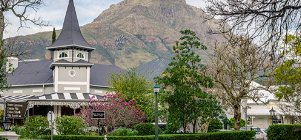The history of Stellenbosch
Stellenbosch is steeped in a rich history that dates back to 1685. Much of the heritage of the town may be unknown to many, owing to its unyielding success in becoming one of the foremost wine-production capitals in the country. It is also renowned as a “student town”, owing to its popular university and characteristic laid-back lifestyle. The area was discovered by Simon van der Stel in 1679 and a “village” came into existence in 1685. At the time, the houses were constructed out of the materials that were readily available and therefore thatched roofs were the norm, a factor that would hinder growth in later years.
However, its remarkable origins cannot be overlooked as they form the base of what has made the town the treasured gem that it is today. The Stellenbosch Heritage Foundation was established in 1959 for this very reason. The foundation strives to promote the “sustainable conservation of the cultural heritage landscape in and around Stellenbosch.”.
Van der Stel was taken aback by the unfettered beauty of the area that he decided to amalgamate part of his own name with the wealth of vegetation, resulting in the name, Stellenbosch – “bosch” is Dutch for “forest”. He also believed that the natural attributes and potential of the land would benefit from immediate settlement and within 12 months the Colony of Stellenbosch came into existence. This can be seen as the official beginning of accommodation in Stellenbosch; this is now widespread throughout the town.
The period from 1776 to 1817 saw accelerated growth; however, in 1803 a fire ran rampant through the town causing much damage to the properties. It was in lieu of this that the traditional thatched roof was discarded and alternative materials were used to rebuild the houses in an effort to reduce the risk of a reoccurrence.
An excerpt from the preamble of t the National Heritage Resources Act states that:
“It helps us to define our cultural identity and therefore lies at the heart of our spiritual well-being and has the power to build our nation. It has the potential to affirm our diverse cultures, and in so doing shape our national character.”
Today, Stellenbosch has blossomed exponentially and is home to a multicultural society and unique atmosphere that draws tourists to it throughout the year. Owing to the influx of tourists, Stellenbosch guest houses are a common sight and highly sought after.





Share This Post